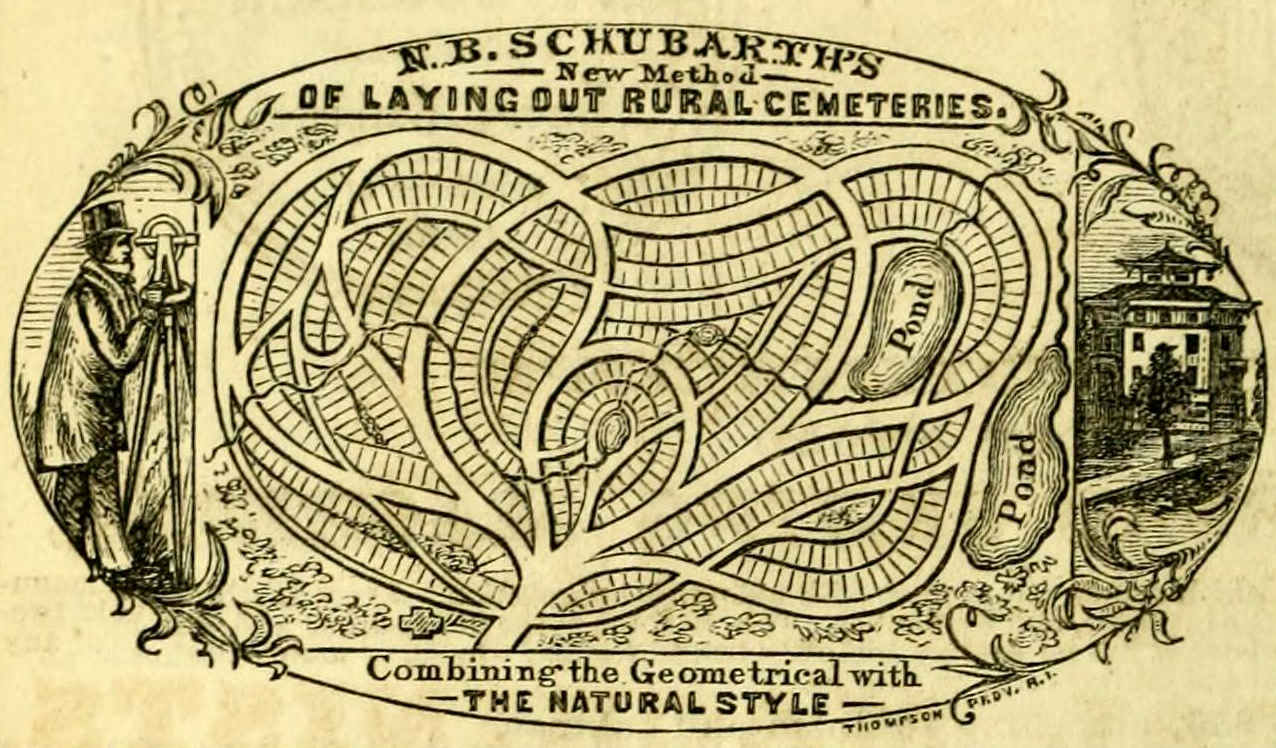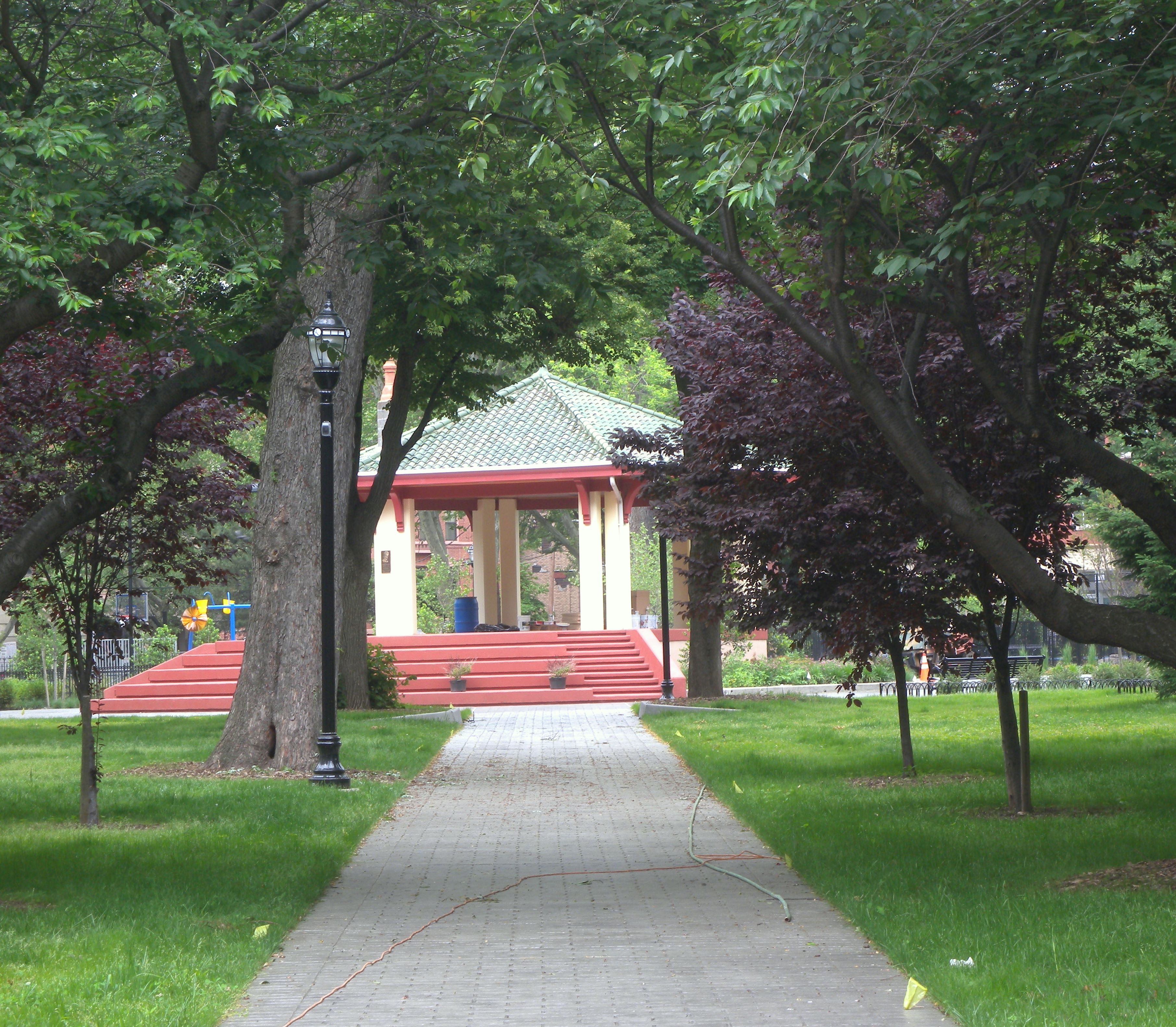|
Jersey City And Harsimus Cemetery
Jersey City and Harsimus Cemetery is a historic rural cemetery located in Jersey City, New Jersey. It was established in 1829 by the first cemetery company founded in the State of New Jersey and is the size of . The cemetery is an early example of Garden Style landscape cemeteries. The cemetery fell into disrepair and was abandoned in 2008. A volunteer group has since been founded to maintain the cemetery. The location of the cemetery was used as an ammunition bunker for the War of 1812 and was a site of skirmishes in 1780 during the Revolutionary War. Since 2011 goats are used for weed control during the summer. Events In order to raise funds for the upkeep of the grounds and caretaker facilities, the all-volunteer organization has partnered with local groups to produce year round events. Events include: * The Ghost of Uncle Joe – A music and theatrical event that occurs in October * Shakespeare in the Park by the Hudson Shakespeare Company. The main Shakespeare compa ... [...More Info...] [...Related Items...] OR: [Wikipedia] [Google] [Baidu] |
Jersey City, New Jersey
Jersey City is the second-most populous city in the U.S. state of New Jersey, after Newark.The Counties and Most Populous Cities and Townships in 2010 in New Jersey: 2000 and 2010 , . Accessed November 7, 2011. It is the of and the county's largest city. [...More Info...] [...Related Items...] OR: [Wikipedia] [Google] [Baidu] |
Harsimus
Harsimus (also known as Harsimus Cove) is a neighborhood within Downtown Jersey City, Hudson County, New Jersey, United States. The neighborhood stretches from the Harsimus Stem Embankment (the Sixth Street Embankment) on the north to Christopher Columbus Drive on the south between Coles Street and Grove Street or more broadly, to Marin Boulevard. It borders the neighborhoods of Hamilton Park to the north, Van Vorst Park to the south, the Village to the west, and the Powerhouse Arts District to the east. Newark Avenue has traditionally been its ''main street''. The name is from the Lenape, used by the Hackensack Indians who inhabited the region and could be translated as ''Crow’s Marsh''. From many years, the neighborhood was part of the " Horseshoe", a political delineation created by its position between the converging rail lines and political gerrymandering. Early settlement Harsimus is a derivative of a Lenape phrase, possibly meaning ''Crow's Marsh''. Spellings i ... [...More Info...] [...Related Items...] OR: [Wikipedia] [Google] [Baidu] |
Rural Cemetery
A rural cemetery or garden cemetery is a style of cemetery that became popular in the United States and Europe in the mid-nineteenth century due to the overcrowding and health concerns of urban cemeteries. They were typically built one to five miles outside of the city, far enough to be separated from the city, but close enough for visitors. They often contain elaborate monuments, memorials, and mausoleums in a landscaped park-like setting. The rural cemetery movement mirrored changing attitudes toward death in the nineteenth century. Images of hope and immortality were popular in rural cemeteries in contrast to the puritanical pessimism depicted in earlier cemeteries. Statues and memorials included depictions of angels and cherubs as well as botanical motifs such as ivy representing memory, oak leaves for immortality, poppies for sleep and acorns for life. From their inception, they were intended as civic institutions designed for public use. Before the widespread developmen ... [...More Info...] [...Related Items...] OR: [Wikipedia] [Google] [Baidu] |
Rural Cemetery
A rural cemetery or garden cemetery is a style of cemetery that became popular in the United States and Europe in the mid-nineteenth century due to the overcrowding and health concerns of urban cemeteries. They were typically built one to five miles outside of the city, far enough to be separated from the city, but close enough for visitors. They often contain elaborate monuments, memorials, and mausoleums in a landscaped park-like setting. The rural cemetery movement mirrored changing attitudes toward death in the nineteenth century. Images of hope and immortality were popular in rural cemeteries in contrast to the puritanical pessimism depicted in earlier cemeteries. Statues and memorials included depictions of angels and cherubs as well as botanical motifs such as ivy representing memory, oak leaves for immortality, poppies for sleep and acorns for life. From their inception, they were intended as civic institutions designed for public use. Before the widespread developmen ... [...More Info...] [...Related Items...] OR: [Wikipedia] [Google] [Baidu] |
War Of 1812
The War of 1812 (18 June 1812 – 17 February 1815) was fought by the United States of America and its indigenous allies against the United Kingdom and its allies in British North America, with limited participation by Spain in Florida. It began when the United States declared war on 18 June 1812 and, although peace terms were agreed upon in the December 1814 Treaty of Ghent, did not officially end until the peace treaty was ratified by Congress on 17 February 1815. Tensions originated in long-standing differences over territorial expansion in North America and British support for Native American tribes who opposed US colonial settlement in the Northwest Territory. These escalated in 1807 after the Royal Navy began enforcing tighter restrictions on American trade with France and press-ganged men they claimed as British subjects, even those with American citizenship certificates. Opinion in the US was split on how to respond, and although majorities in both the House and ... [...More Info...] [...Related Items...] OR: [Wikipedia] [Google] [Baidu] |
American Revolutionary War
The American Revolutionary War (April 19, 1775 – September 3, 1783), also known as the Revolutionary War or American War of Independence, was a major war of the American Revolution. Widely considered as the war that secured the independence of the United States, fighting began on April 19, 1775, followed by the Lee Resolution on July 2, 1776, and the Declaration of Independence on July 4, 1776. The American Patriots were supported by the Kingdom of France and, to a lesser extent, the Dutch Republic and the Spanish Empire, in a conflict taking place in North America, the Caribbean, and the Atlantic Ocean. Established by royal charter in the 17th and 18th centuries, the American colonies were largely autonomous in domestic affairs and commercially prosperous, trading with Britain and its Caribbean colonies, as well as other European powers via their Caribbean entrepôts. After British victory over the French in the Seven Years' War in 1763, tensions between the motherland and he ... [...More Info...] [...Related Items...] OR: [Wikipedia] [Google] [Baidu] |
Shakespeare In The Park
Shakespeare in the Park is a term for outdoor festivals featuring productions of William Shakespeare's plays. The term originated with the New York Shakespeare Festival in New York City's Central Park, originally created by Joseph Papp. This concept has been adapted by many theatre companies, and over time, this name has expanded to encompass outdoor theatre productions of the playwright's works performed all over the world. Shakespeare in the Park started as an idea to make theatre available to people of all walks of life, so that it would be as readily available as library books. The performances are more often than not free admission to the general public, usually presented outdoors as a summer event. These types of performances can be seen by audiences around the world, with most festivals adapting the name for their productions, such as Vancouver's Bard on the Beach. Many festivals incorporate workshops, food, and other additions to the performances making this type of theatr ... [...More Info...] [...Related Items...] OR: [Wikipedia] [Google] [Baidu] |
Hudson Shakespeare Company
The Hudson Shakespeare Company is a regional Shakespeare touring festival based in Jersey City in Hudson County, New Jersey, that produces an annual summer Shakespeare in the Park festival and often features lesser done Shakespeare works such as ''The Two Noble Kinsmen'' and ''Timon of Athens''. The company also produces several modern-day productions in non theatrical venues such as their courtroom shows of '' Inherit the Wind'' and ''A Few Good Men'' in the Hoboken Municipal Courtroom. It produce a yearly educational program that ranges from student workshops to full length Shakespeare productions. History In 1992, Jersey City native L. Robert "Luther" Johnson decided to mount a staged reading of "A Midsummer Night's Dream" in Hamilton Park in Jersey City. Having worked as a technical consultant for such companies as Riverside Shakespeare and New York Gilbert and Sullivan Players in New York, Johnson remarked "I noticed that when you were on one side of the Hudson you couldn't ... [...More Info...] [...Related Items...] OR: [Wikipedia] [Google] [Baidu] |
Hudson County
Hudson County is the most densely populated county in the U.S. state of New Jersey. It lies west of the lower Hudson River, which was named for Henry Hudson, the sea captain who explored the area in 1609. Part of New Jersey's Gateway Region in the New York metropolitan area, the county's county seat and largest city is Jersey City,New Jersey County Map . Accessed July 10, 2017. whose population as of the was 292,449. As of the |
Constitution Day
Constitution Day is a holiday to honour the constitution of a country. Constitution Day is often celebrated on the anniversary of the signing, promulgation or adoption of the constitution, or in some cases, to commemorate the change to constitutional monarchy. * Abkhazia, 26 November (1994). See Constitution of Abkhazia. * Andorra, 14 March (1993). Known locally as ''Dia de la Constitució''. See Constitution of Andorra. * Argentina, 1 May (1853). See Constitution of Argentina. ''Not a public holiday.'' * Armenia, 5 July (1995). See Constitution of Armenia. * Australia, 9 July (1900). See Constitution of Australia. ''Not a public holiday.'' * Azerbaijan, 12 November (1995). See Constitution of Azerbaijan. ''Not a public holiday.'' * Belarus, 15 March (1994). Known locally as ''Dzień Kanstytucyji''. See Constitution of Belarus. * Belgium, 21 July (1890). Known locally as ''Nationale feestdag van België'' (in Dutch) and ''Fête nationale belge'' (in French). ** Day of the Flemi ... [...More Info...] [...Related Items...] OR: [Wikipedia] [Google] [Baidu] |
World War II
World War II or the Second World War, often abbreviated as WWII or WW2, was a world war that lasted from 1939 to 1945. It involved the vast majority of the world's countries—including all of the great powers—forming two opposing military alliances: the Allies and the Axis powers. World War II was a total war that directly involved more than 100 million personnel from more than 30 countries. The major participants in the war threw their entire economic, industrial, and scientific capabilities behind the war effort, blurring the distinction between civilian and military resources. Aircraft played a major role in the conflict, enabling the strategic bombing of population centres and deploying the only two nuclear weapons ever used in war. World War II was by far the deadliest conflict in human history; it resulted in 70 to 85 million fatalities, mostly among civilians. Tens of millions died due to genocides (including the Holocaust), starvation, ma ... [...More Info...] [...Related Items...] OR: [Wikipedia] [Google] [Baidu] |
Charles F
Charles is a masculine given name predominantly found in English and French speaking countries. It is from the French form ''Charles'' of the Proto-Germanic name (in runic alphabet) or ''*karilaz'' (in Latin alphabet), whose meaning was "free man". The Old English descendant of this word was '' Ċearl'' or ''Ċeorl'', as the name of King Cearl of Mercia, that disappeared after the Norman conquest of England. The name was notably borne by Charlemagne (Charles the Great), and was at the time Latinized as ''Karolus'' (as in ''Vita Karoli Magni''), later also as '' Carolus''. Some Germanic languages, for example Dutch and German, have retained the word in two separate senses. In the particular case of Dutch, ''Karel'' refers to the given name, whereas the noun ''kerel'' means "a bloke, fellow, man". Etymology The name's etymology is a Common Germanic noun ''*karilaz'' meaning "free man", which survives in English as churl (< Old English ''ċeorl''), which developed its depr ... [...More Info...] [...Related Items...] OR: [Wikipedia] [Google] [Baidu] |









